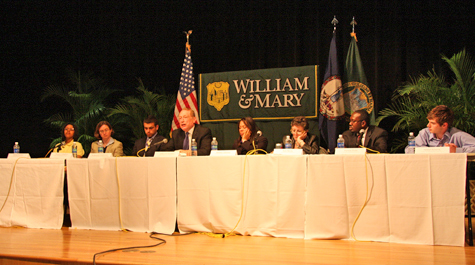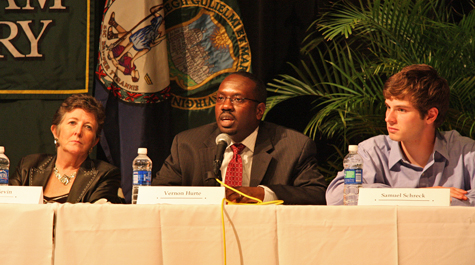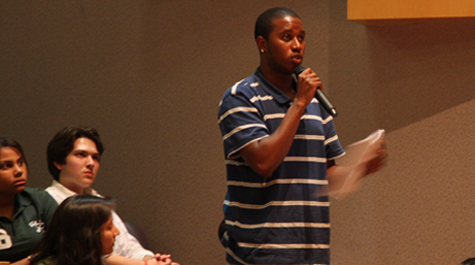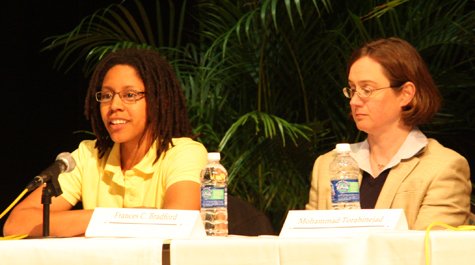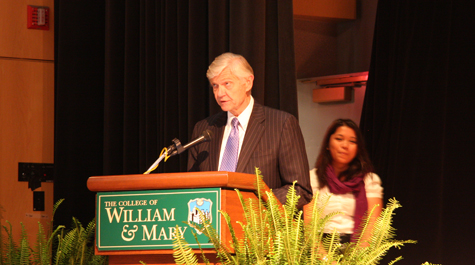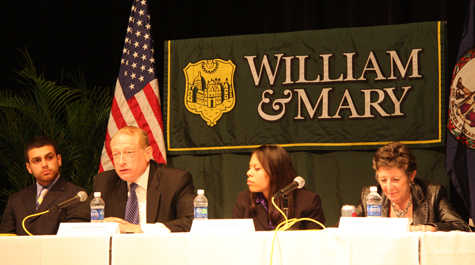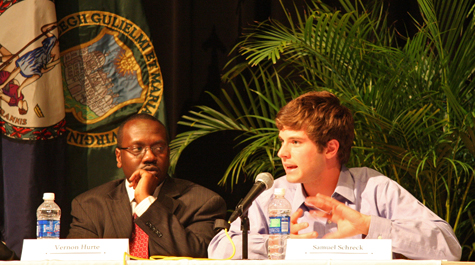Panelists discuss the state of diversity at W&M
"Engaging our differences with sympathetic understanding is hard work," said President Taylor Reveley. "I don't think we shrink from this hard work at William & Mary."
The Monday night forum, entitled "Identity Crisis? 2010 State of Diversity Forum at William and Mary," served as the culminating event for the College's "I am W&M" campaign, a week of events that sought to explore the diverse personal stories and identities of the campus community's members. The panelists included Jeff Trammell '73, a member of the Board of Visitors; Vernon Hurte, director of the Center for Student Diversity; Fran Bradford, associate vice president for government relations; Kate Slevin, chancellor professor of sociology; Richael Faithful '07; Brittney Calloway '11; Sam Schreck '11; and Mohammad Torabinejad '10. Shay Jannat '10 served as the event's moderator.
"Diversity is as hot a topic as it has ever been at William & Mary, and we are at a great phase of transition and change, but in order for us to effectively move forward, we have to constantly reevaluate the past as well as our present," said Jannat. "So our big question is how can we actively and openly demonstrate our commitment to the awareness of and appreciation for diversity and equal opportunity at the College of William and Mary?"
The gains of cultural dexterity
In opening remarks, Reveley said that individuals and communities gain much from possessing "cultural dexterity."
"They learn how to engage differences from themselves with sympathetic understanding, celebrating differences as they enhance the human experience and struggling to avoid letting differences become the occasion for discrimination, harassment and worse," he said. "The greater the cultural dexterity of an individual or an university or a nation, the greater its capacity to thrive in this century where diversity is increasingly the norm."
Reveley added that achieving this dexterity would be the result of hard work.
"At William & Mary this hard work will require, for instance, for us to understand and acknowledge our racial past and attempt to reconcile it with our aspirations for the future, thus the Lemon Project on which we are now embarked," he said. "We know it requires us to become a genuinely welcoming society for people of all sorts, including people who differ from us in ways that we may find initially difficult to understand, much less accept, thus the hard work of our diversity committee. It will require that we learn how to talk to one another across our differences as fellow human beings, all part of this university and community."
The changing definition of diversity
Historically, the definition of diversity has centered on labels, whether they be racial, religious or otherwise. However, Hurte told the audience, we should focus on the whole human experience.
"Diversity includes the unique experiences that each individual brings to the table and that includes some of the areas that we can visually see - racial and ethnic diversity - and sexual orientation, religious and other cultural differences and similarities," Hurte said. "Those things are certainly still part of the discussion. But it's much broader than that, even when we look at the William & Mary community and look at the richness that comes from each student, every member of this community.
"It helps us understand that diversity is much broader than we've historically considered."
Trammel said diversity is a "a way of getting acquainted with reality."
"The reality of it is there are and always have been people of different religious, ethnic, sexual orientation, gender identity, gender, etc. as part of who we are as people," he said. "What we've done in much of our history is ... we have ignored reality."
Decades ago, he said, it would have been inconceivable to have a forum on state of diversity at William & Mary. In another few decades, Trammell added, it might be just as inconceivable to have one because diversity is taken for granted.
"We are at that threshold of change and we are part of that change," he said. "It's exhilarating."
He added that if you spend time outside of William & Mary, "you quickly realize that this is a special place."
"We are seen as being a leader in this area, and for good reason," Trammell said.
Still more work to do
While there has been progress, the panelists agreed here is much that still needs to be done.
Slevin said that members of majority groups must engage in these conversations.
"The majority has to be constantly reminded that they are the majority. Not to make them paranoid, but to say, we who are the majority need to bend over backward - that's our job as the majority - to welcome on a daily basis those who are different from us and to not make them feel as if they are constantly different," she said.
Torabinejad added that minority members must also be careful to not "self-segregate."
"If we're going to segregate based on simple visible things, how is it that we are ever going to talk about things like sexual orientation or religion or mental health issues, which aren't as visible? We're never going to get past that barrier," he said.
Torabinejad added that all students must also take what they learn in the classroom and apply those lessons to their lives.
"If you just leave all those concepts at the door and you don't apply them to your relationships or your friends or peers on campus or off campus, you are really doing yourself a disservice," he said. "I have faith in the student body here that we're going to push for positive change."
The balancing act of a public university
Acknowledging the reality that hot-button diversity issues on campus can evoke a political response, the panelists noted the balance that William & Mary must strike between being a public university and pursuing its objectives.
"We have to acknowledge that other folks have opinions different than our own and we have to respect them, whether we agree with them or not, and whether we know that ultimately they are probably not in direction we want to go," said Bradford. "When progress is being made - and in these issues of diversity, I think that progress is being made - you often hear the opposition's voices louder than your own. What I would say is don't be discouraged. Be encouraged. Because the louder they scream, the more progress you are making."
Hurte said that the College must hold onto its values even as it faces opposition in the political arena.
"If we're going to be successful at this thing called diversity, if we're going to be successful at creating and maintaining a true welcoming and inclusive environment for this community, then the College -- even in the midst of political challenges -- can't afford to lose sight of what we're about," Hurte said.
Several students and community members asked questions of the panelists, including how can groups such as hourly workers be brought into these discussions on diversity and what can graduating seniors do to continue seeking diversity once they graduate from the College.
"There's still work being done, but we're getting closer to understanding that not only is it reality to understand our differences but I think there is a lot to be said about just being a 21st-century citizen," said Faithful. "If you don't get it here and you go our into the world, you're going to be left behind because the world is changing pretty rapidly."
Jessee Vasold '11 asked what steps are being taken to address concerns of students who do not feel that William & Mary is in a good place. Hurte said that, for one thing, the College is trying to be connected with as many students as possible so they can share their experiences.
The College must "stay connected to the experiences of students," he said.
Slevin added there is still much more work to do at William & Mary but she has seen vast improvements since the time she came to the College.
"I am delighted every day at the diversity that I see, and the commitment that I see," she said. "It doesn't mean that we don't make mistakes. It doesn't mean that we drop the ball sometimes, but the will is there to make things better."
 Skip to main content
Skip to main content

